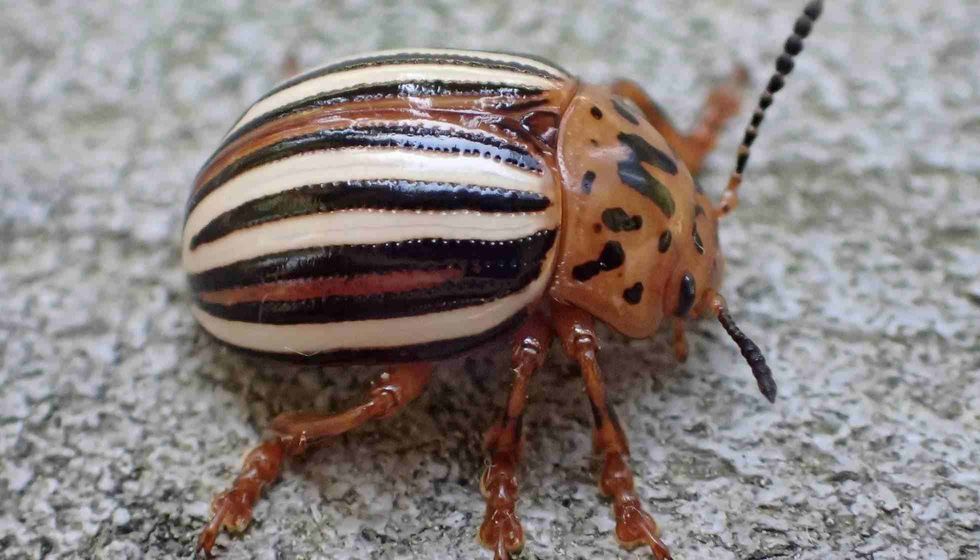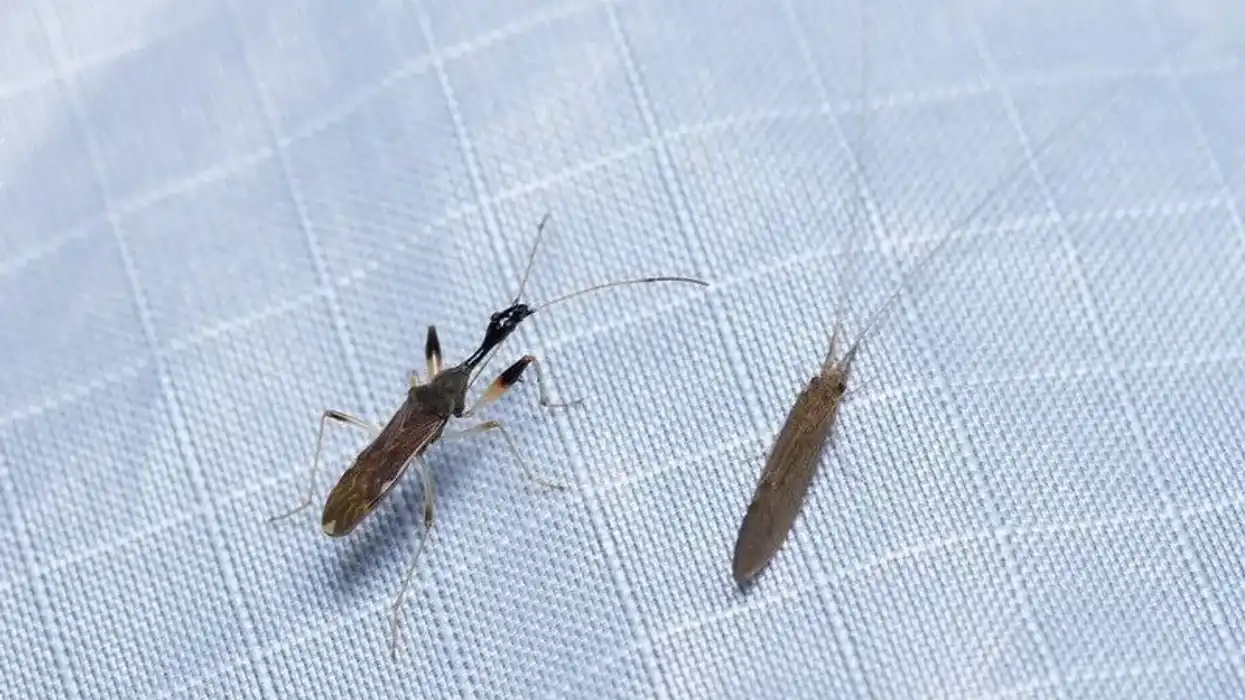The mysterious nature of the world of animals never ceases to surprise us. In North America, there lives an insect known as the false potato beetle (Leptinotarsa juncta) that looks eerily similar to the Colorado potato beetle (Leptinotarsa decemlineata).
The latter is a pest found in potatoes, while the former mainly lives on the Carolina horsenettle (Solanum carolinense) plant. It is also seen on ground cherry and the husk tomato plant.
Both the insects' pale yellow wing pads have dark and light stripes, which give a strikingly similar look. However, the wing of the false potato beetle, with one contrasting white stripe, is brown compared to the white of the Colorado potato beetle.
As a North American beetle species, the false potato beetle is mainly found in the U.S. It inhabits throughout U.S. states like Florida, Maryland, Missouri, and Texas.
Females have been observed to lay eggs on the underside of leaves of the Solanum carolinense plant or other host plants. A larva has to go through different stages before turning into an adult beetle. There is no need to get rid of this beetle as it is completely harmless and does not cause any damage to crops.
Want to know more about this orangish-yellow-red-striped beetle? Then, keep reading to read false potato beetle facts. Also, check out the articles on Atlas beetles and soldier beetles to tour the world of beetles.
False Potato Beetle Interesting Facts
What type of animal is a false potato beetle?
The false potato beetle (Leptinotarsa juncta) is a type of beetle that is found in the USA.
What class of animal does a false potato beetle belong to?
Just like other beetles, the false potato beetles also belong to the class Insecta. This insect is classified under the Chrysomelidae family and in the Leptinotarsa genus. It is closely related to the Leptinotarsa decemlineata or Colorado potato beetle and shares the same genus.
How many false potato beetles are there in the world?
The exact population of the false potato beetle is yet to be known.
Where does a false potato beetle live?
False potato beetles are found in the Mid-Atlantic United States and the Southeastern United States. It can also be traced to Maine.
It is primarily found in states like Florida, eastern Texas, north Missouri, southern Illinois, Indiana, east Maryland, West Virginia, as well as in Virginia. Compared to the false potato beetle, the Colorado potato beetle is also found in Central America, Mexico, and even Canada.
What is a false potato beetle's habitat?
The false potato beetle is mainly found on the ground, and it likes to dig into the soil. It can be found on noxious weeds and horse-nettle growing in the ground. These beetles aren't found in potatoes like the Colorado potato beetle (Leptinotarsa decemlineata), which is also known as the true potato beetle.
Who do false potato beetles live with?
Not much is known about the living patterns of the false potato beetle, but the insects are often seen in groups.
How long does a false potato beetle live?
Even though not much is known about the exact lifespan of the false potato beetle, it shares a similar life cycle with the Colorado potato beetle. The latter can have a life that lasts for just 30 days, and multiple generations of beetles are seen every year.
How do they reproduce?
Just like the Colorado potato beetle, the false potato beetle also starts a new life by laying its eggs. The main goal of the adult of this species is to mate to increase its population.
An adult female can lay up to 500 or more under the leaves of host plants like Solanum carolinense. The eggs are laid in a clutch of 20-60 eggs and remain stuck to each other. Eggs of false potato beetles tend to be larger than the Colorado potato beetle.
Once the eggs hatch, pale white larvae come out, and it has black spots on top of it. The larvae belonging to the Colorado potato beetle are red or orange and have two rows of black spots instead of the one row found in false potato beetles.
These larvae mainly feed on the host plant to sustain themselves, and the larvae stage lasts for around 21 days. Afterward, the larvae drop to the ground to start their change into a pupa which lasts for 10-15 days.
What is their conservation status?
The false potato beetle isn't listed in any conservation lists.
False Potato Beetle Fun Facts
What do false potato beetles look like?

Both the false potato beetle and the Colorado potato beetle are regarded for their similar appearance in the adult stage. The round and plump beetles have an orangish-red body.
They also have several white and black stripes on their back. It is hard to differentiate between the species.
The insects have horizontal black stripes on each pale yellow elytron (wing covering). In the Colorado potato beetle, each elytron has even black and white stripes, but in the false potato beetles, there is a slight brown or orange stripe beside the black stripes on top of the elytron.
The legs are orange or while the underside is dark or brown. Apart from the elytron, the head and thorax of the adults also contain black spots or markings.
In the larvae stage, there is a distinct difference between the Colorado potato beetle and the false potato beetle, as the former has brighter orange-colored larvae with two rows of dots. On the other hand, the false potato beetle has pale larvae with a single row of dots on its body.
How cute are they?
Even though these insects look striking, we wouldn't call them cute.
How do they communicate?
Not much is known about the communication processes used by this beetle. On looking at the general communication process of beetles, it includes communicating with the help of chemicals as well as scents.
How big is a false potato beetle?
The average size range of the false potato beetle adults can go up to 0.3-0.4 in (9-11 mm). It is similar in size to the Colorado potato beetle adults, which makes the two species look quite alike.
How fast can a false potato beetle move?
We couldn't find any data about the speed range of the false potato beetle.
How much does a false potato beetle weigh?
No conclusive weight could be found for adults, but we can assume it to be lightweight because of its small size.
What are the male and female names of the species?
There are no distinct names for the males or females of this species.
What would you call a baby false potato beetle?
A baby false potato beetle is known as a larva.
What do they eat?
Unlike the Colorado potato beetle (Leptinotarsa decemlineata), the false potato beetle doesn't rely on potatoes, and neither is it a common pest on crop fields. This beetle primarily feeds on the Carolina horsenettle (Solanum carolinense) and other plants that commonly grow on the ground.
Feeding also takes place on husk tomato or ground cherry plants. This beetle also feeds on eggplant and woody nightshade plants. It chomps down on these host plants throughout the larva stage before turning into a pupa.
Are they poisonous?
No, the false potato beetle isn't poisonous. Even the Colorado potato beetle doesn't produce any poison.
Would they make a good pet?
If you happen to find a false potato beetle near your home, you may try to keep it as a pet. However, this round orange insect species wouldn't understand your appreciation towards it.
Did you know...
Adults often burrow into the soil to overwinter.
The Colorado potato beetle and the false beetle aren't able to crossbreed even after belonging to the same genus Leptinotarsa.
The University of Florida has done a considerable amount of extensive research on both beetle species.
How do you get rid of potato beetles?
You do not need to get rid of these beetles as it isn't a pest. The insects are commonly seen on the ground, and they will chomp on the host plants.
On the other hand, the Colorado potato beetle is a serious pest, and its groups can easily damage plants. It is also better to check the insect feeding on your plant or crop before completely getting rid of it.
If there is a Colorado potato beetle infestation on your farm, you can use certain chemicals to get rid of the insects. Another common way is to introduce predators like stink bugs, green lacewings, or spined soldier bugs.
Crop rotation can also be an easy way to get rid of bugs. Using similar ways will also get rid of the false potato beetles and the three-lined potato beetles.










